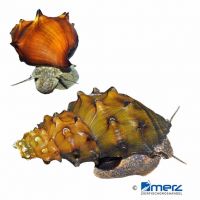Armed Pagoda Snail (Brotia armata)
| Armed Pagoda Snail Brotia armata | |
|---|---|
| Name | Armed Pagoda Snail |
| Name Lat. | Brotia armata |
| Family | Pachychilids |
| Family lat. | Pachychilidae |
| Order | Caenogastropods |
| Order lat. | Caenogastropoda |
| Origin | Southeast Asia |
| Habitat | Streams |
| Diet | Algae, detritus, vegetables |
| pH | 6.5-8.0 |
| Behavior | Peaceful |
| Keeping | Individual, pair, group |
| Care Level | Moderate |
| Reproduction | Oviparous |
| Breeding | Moderately difficult |
| Life Span | 2-5 years |
| Protection | No |
| Metric Units | |
| Size | 4 cm |
| Temperature | 18-25 °C |
| Hardness | 5-15 °dH |
| Aquarium | ~ 50 l |
| US Units | |
| Size | 1.6" |
| Temperature | 64-77 °F |
| Hardness | 89-267 ppm |
| Aquarium | ~ 15 gal |
Distribution and habitat
The Armed Turret Snail originates from Thailand and is now widespread in the Southeast Asian region. They live in rivers and streams with moderately strong currents on rocks and stones just above and below the water surface.
Maintenance
The aquarium should have border planting and be structured with large river pebbles, stones and roots. A coarse-grained substrate covered with some foliage (e.g. sea almond leaves, oak leaves) and a medium-strong current is ideal.
No ammonia, ammonium and nitrite should be detectable in the aquarium water, the nitrate value should not exceed 100 mg/l. To ensure the water quality and oxygen content, a filter and heater adapted to the aquarium size is required, as well as lighting for the species-appropriate day-night rhythm of the animals. When choosing the filter, special care should be taken to ensure that the animals cannot be sucked in.
Diet
They feed predominantly on growth organisms, which they rasp from stones, roots and furnishings, but also eat detritus and plant food. Algae leaves (nori, kelp), food tablets with a high spirulina content or scalded vegetables can be offered as a supplement, but these are not always accepted immediately. The plants in the aquarium do not serve as food for them and therefore remain unharmed
Unaccepted food must be siphoned off after 2-3 hours. Regular and varied feeding promotes health and prevents deficiency symptoms
Behaviour and compatibility
They can be socialized with all fish species that do not consider snails as food.
In principle, only mutually compatible species with similar requirements for water quality and water temperature may be socialized.
Reproduction and breeding
There are no known external distinguishing characteristics of the sexes.
They are separately sexual and mating takes place only once a year. The female has a special brood pouch in which the development of the fertilized eggs to the young snails takes place. When they leave the brood pouch, these snails appear to be viviparous. One litter consists of 10-200 young.
Important
As inhabitants of flowing waters, they require clean, oxygen-rich water and cannot tolerate water temperatures above 25 °C on a permanent basis. Since they leave the water again and again, a distance of 5-10 cm from the water surface to the upper edge of the aquarium should be maintained and a cover should not be dispensed with.
In nature they live hidden under stones or dead wood during the day. In aquarium keeping they can also be diurnal
To build their shell they need a sufficient supply of lime. Especially in soft, acidic water, shell damage (holes) can occur due to lack of lime, which can lead to the death of the snail. Therefore, special attention should be paid to the calcium concentration in the water and, if necessary, calcium should be added in the form of limestone, cuttlebone or special preparations from the specialized trade. The foliage (sea almond tree, oak, beech, etc.) not only provides cover, but when rotting promotes the development of microorganisms, which are a valuable secondary food source
The well-being of the animals should be monitored regularly. Temperature should be checked daily, pH, hardness and nitrate levels at least every 14 days. Regular partial water changes are recommended, even when contaminant levels have not yet reached the upper limit. Sudden changes in water quality should be avoided. Newly introduced animals must be accustomed slowly to the water in the aquarium.
Further literature can be found in your pet store.
References
Text: Barbara Pachner; Image: Merz Zierfischgroßhandel
Source: BITTER (2008): Schnecken-Fibel, Dähne Verlag; ENGELMANN & LANGE (2011): Zootierhaltung - Tiere in menschlicher Obhut: Wirbellose, Verlag Harri Deutsch
